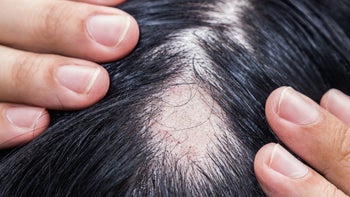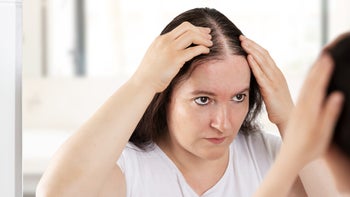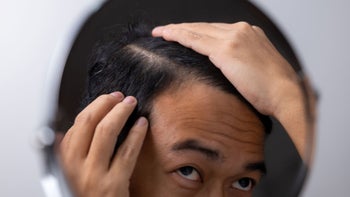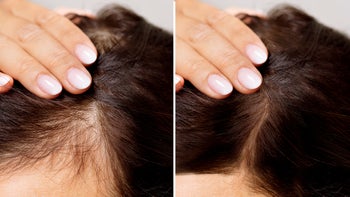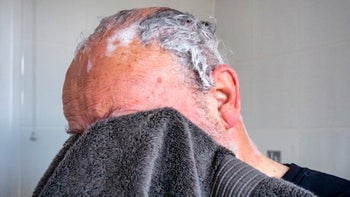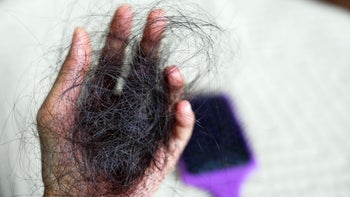
A Guide to Hair Loss in Women: Causes and Treatment for Thinning Hair
Key takeaways:
There are several causes of hair loss and hair thinning in women. The most likely cause depends on your age and the pattern of hair loss.
Most types of hair loss are treatable, but some can be permanent. Either way, hair loss can be a scary and traumatic experience.
Successful hair regrowth is often possible. It starts with identifying the underlying reason you’re losing hair.
Access savings on related medications
Table of contents
Most people lose about 50 to 100 hairs every day — and that’s totally normal. But if you notice hair thinning that goes beyond this, know that you aren’t alone.
Hair loss in women is common, and it can happen at any age. By age 50, about 4 in 10 women have noticeable hair loss. And while it can be stressful, it’s often treatable. The first step is to find out what’s causing it.
Your age matters when it comes to causes. The most common reasons for hair loss in younger people are different from those in older adults. Whatever your age, identifying the cause of hair loss and addressing it early is important.
For Every Era of You
Expert solutions made for women, by women. OLLY's here to support you through every age, stage & magnificent mood change.*


*These statements have not been evaluated by the Food and Drug Administration. This product is not intended to diagnose, treat, cure, or prevent any disease
Hair growth cycle
Your hair goes through different cycles. And this helps explain why it’s normal to lose some hair every day.
These are the three stages of the hair follicle cycle:
Anagen (growth): This is when your hair is actively growing. Most of your hairs are in this stage at any given time, and it can last for years.
Catagen (transition): In this transitional phase, your hair stops growing. It lasts a few weeks.
Telogen (resting): This resting phase ends once your hair falls out. But it can take a few months before this happens.
Not all of your hairs are on the same timeline. That’s why, with normal hair shedding, you’ll lose around 50 to 100 strands a day. But if you notice more hair loss than that, like clumps coming out, it’s best to look into what’s going on.
What causes hair loss in young women?
Few people expect hair loss to happen as early as their 20s or 30s. When it does happen, it’s usually caused by a specific trigger that can be reversed. The most common triggers for hair loss in young women are stress, dieting, and hormonal changes. Less commonly, hair loss can be caused by certain autoimmune disorders.
1. Stress
Stressful events are a leading cause of hair thinning in women. From COVID-19 and job loss to relationship breakups and childbirth, there are many causes of stress-induced hair loss. Stressful events can cause your body to enter “survival mode,” where it rations fuel and energy to support its most vital functions.
A body under stress pushes hairs out of the growth phase and into the resting phase, causing them to eventually fall out. This type of hair loss is called telogen effluvium.
In telogen effluvium, you might see your hair start shedding around 3 months after a very stressful event, and it can last for 3 to 6 months. Although this hair loss may feel sudden, you won’t go bald from stress-induced hair loss. Once the stress passes, most people see regrowth 3 to 6 months later. Depending on how long your hair is, it can take 12 to 18 months to see full regrowth.
2. Dieting
Crash dieting can have two negative effects on your hair. First, your body perceives rapid weight loss as a stressful event — it thinks you’re starving. Second, it might mean that you’re not getting the nutrients your body needs to grow healthy hair. In times of stress or nutrient shortages, your hair is the first thing to go.
Hair loss from a stressful event normally corrects itself over time. But, if the stress is ongoing and you have a protein or vitamin deficiency from excessive dieting, it could limit the hair’s ability to grow back. Dieting can also change how hair looks, making it drier, duller, and more prone to breaking.
3. Hormonal changes and imbalances
Hormonal changes can affect hair growth. Specifically, higher estrogen levels make your hair thicker and fuller. When estrogen levels drop, hair falls out. But hair loss should stop as your body adjusts to your new estrogen levels.
While estrogen helps hair, progesterone can cause or worsen hair loss. Some popular progesterone-based birth control medications associated with hair loss are:
Implants like Nexplanon
Depo-Provera (medroxyprogesterone), the birth control shot
Birth control patches, like Xulane (norelgestromin/ethinyl estradiol)
NuvaRing (etonogestrel / ethinyl estradiol), the birth control vaginal ring
Women with health conditions that cause hormone imbalances also have a higher risk of hair loss. Examples include hypothyroidism, polycystic ovarian syndrome (PCOS), and congenital adrenal hyperplasia.
Your primary care provider might test your hormone levels to see if you have one of these conditions, particularly if you have hair loss along with symptoms like:
New hair growth on the face or body
Difficulty losing or gaining weight
Irregular periods
Difficulty tolerating changes in temperature
If your hair loss is from a progesterone-based birth control, it should resolve when you stop using that birth control. If the issue is a hormone imbalance, identifying and correcting the imbalance is necessary for regrowth.
4. Pregnancy
Your body experiences different hormonal changes during and after pregnancy. And these changes can affect how much hair you shed. Many have a thicker, fuller head of hair during pregnancy due to a boost in estrogen, which triggers more hairs to stay in the resting phase.
But estrogen levels drop after delivery. So you may shed more hair than usual during this time. Increased hair shedding usually peaks 3 to 4 months after childbirth. But postpartum hair loss is temporary. Most will get back their normal hair fullness within 1 year.
5. Autoimmune conditions
Female hair thinning or loss can be caused by an autoimmune condition, but this is less common. This means the body’s immune system reacts against the hair, causing it to fall out.
Autoimmune conditions that can affect hair growth in younger women include:
Systemic lupus erythematosus: Lupus can cause hair to thin all over and create bald patches that scar. Early treatment of lupus is key to prevent irreversible damage.
Alopecia areata: This occurs when the body’s immune system reacts against hair follicles. Most often, alopecia areata appears as a bald patch in a perfect circle. It can come up anywhere on the body, but it’s most noticeable on the scalp. Sometimes it gets better on its own. But the bald patches can come back randomly.
What causes hair loss in middle-aged women?
Hair loss becomes more common in your 40s and 50s. For most women, this is genetic. And hair loss may get worse once menopause comes. Aside from genetics and hormones, the effects of certain hair care practices tend to catch up in these decades.
1. Genetics or female-pattern hair loss (FPHL)
Genetics is the most common reason for hair loss in both men and women. You can inherit the genes for hair loss from one or both of your parents. Female-pattern hair loss (androgenetic alopecia) usually starts after the age of 40. Roughly 40% of women have noticeable hair loss by the age of 50. And less than half of women get through life with a full head of hair.
Hereditary hair loss looks a little different in women than it does in men. You might find that your part is wider or your hairline is farther back than it used to be. In most women, hair thinning slowly increases over the years. But, without treatment, it might affect the whole scalp.
Women tend to lose less hair than men do. But, compared with men, women tend to socialize less and have poorer quality of life because of hair loss. Fortunately, early treatment can stop and even reverse the process in most cases.
2. Menopause
With menopause comes a dramatic drop in estrogen levels. This causes hair to become thinner (especially at the top and sides of the scalp) and to grow more slowly. Some women will also notice more facial hair. If you are prone to hereditary hair loss, menopause makes it worse.
Another possible reason for hair loss after menopause is a condition called postmenopausal frontal fibrosing alopecia. In this type of hair loss, inflammation destroys hair follicles and leaves scarring, affecting the hairline and the eyebrows. The sooner this is diagnosed and treated, the better. Once scarring sets in, hair can’t grow back.
3. Hair styling
Traction alopecia is hair loss from excess stress on the hair. When it comes to hair loss in middle age, this could be related to styling you did in your 20s and 30s. (But you may have more immediate, sudden hair loss from chemical treatments that can burn the scalp.)
Relaxers and hot combs cause inflammation. Braids, weaves, and tight ponytails put pressure on hair roots. These practices damage hair follicles and can lead to scarring and permanent hair loss. The first sign of styling-related damage might be thinning at the hairline or loss of hair at the top of the scalp.
Hair loss in your 60s and beyond
Hair growth and regeneration slows down with age. Health problems can also take their toll on your hair, and some medications may also cause hair loss.
1. Aging
Hair aging begins in your 60s and is just as real as skin aging. Individual hairs, now gray or white, become thinner and fewer. And it takes longer to regrow ones that fall out. Unlike the wider part and receding hairline in hereditary hair loss, hair loss from aging takes place everywhere.
Sun damage can speed up hair aging. Like pigment in your skin, pigment in your hair is protective. Hairs that have turned gray or white are more vulnerable to ultraviolet (UV) rays. Using hats and hair products with sunscreen can help prevent damage.
2. Health problems
Medical conditions can cause or contribute to hair loss. In particular, hypothyroidism, anemia, and nutritional deficiencies, which are more common in older age, can cause hair loss.
In addition, cancer and cancer treatments are known to cause hair loss. Chemotherapy and radiation therapy can damage hair follicles (anagen effluvium). Most people will recover lost hair about 1 year after treatment is complete, though it’s common for hair to be grayer or whiter afterward.
3. Medications
People tend to take more prescription medications as they get older. Several medications can cause hair loss as a side effect. If you think a medication is causing hair loss, talk with your healthcare team. They can figure out if an alternative is right for you.
Some common medications that could cause hair loss include:
Antidepressants: bupropion (Wellbutrin) and selective serotonin reuptake inhibitors (SSRIs), such as fluoxetine (Prozac), paroxetine (Paxil), and sertraline (Zoloft)
Blood thinners: heparin, warfarin (Coumadin), and apixaban (Eliquis)
Beta blockers (blood pressure medications): propranolol (Inderal), metoprolol (Lopressor, Toprol), atenolol (Tenormin)
Seizure medications: valproic acid (Depakote), pregabalin (Lyrica), levetiracetam (Keppra)
Women’s hair loss treatments
There are many ways to support hair regrowth. From preventive lifestyle habits and supplements to medications and cosmetic procedures, we’ve got you covered with hair loss treatment tips.
Lifestyle habits for healthy hair
Hair is an extension of the body, so living a healthy lifestyle is key to regrowing hair. Here are some things to keep in mind:
Eat a well-balanced diet.
Take steps to manage your stress.
Limit hair treatments, heat styling, and the number of hair products you use.
Protect your hair and scalp from the sun.
See your primary care provider regularly for preventive medical care.
Supplements that may help hair loss
Currently, there are no FDA-approved hair loss supplements. But vitamin and mineral deficiencies likely contribute to hair loss. To find out if you’re deficient in a nutrient that’s affecting your hair, you can go to your doctor’s office for blood work.
Research has linked low levels of iron, vitamin D, and zinc to increased shedding and hair loss. If you’re too low in a particular vitamin or mineral, they’ll prescribe the appropriate supplements to correct your levels.
Keep in mind that there are some risks to taking supplements. For example, taking biotin can lower the levels of cardiac enzymes (substances that the heart releases when it’s injured) in the blood, which can lead to missing an important sign of a heart attack. It can also falsely make the results of your thyroid function tests higher than what they really are. Too much vitamin D can damage your kidneys. And high levels of vitamin A can actually make you lose hair.
Medications to treat hair loss
For hair loss that doesn’t get better on its own, there are medications that may help:
Minoxidil (Rogaine): Topical minoxidil (a solution or foam) is the first-choice medication for many types of hair loss.
Spironolactone (Aldactone): Research shows that spironolactone can help with many conditions, including female-pattern hair loss. This is an off-label use, and you’ll need a prescription.
Finasteride (Proscar, Propecia): Finasteride isn’t FDA-approved for use in women and may cause birth defects. But dermatologists may recommend off-label oral finasteride after menopause.
Triamcinolone steroid injections: A dermatologist can inject triamcinolone into the scalp to help promote hair regrowth in certain types of hair loss.
And researchers continue to look for new treatments for alopecia areata.
Other forms of hair loss treatment
Other treatment options include cosmetic and surgical procedures at a dermatologist’s office. Some of these treatments are still experimental, but they show promise:
Microneedling: This is a newer skin treatment that increases collagen production, which helps keep skin strong and healthy. Microneedling also stimulates stem cells in the hair follicle and promotes growth.
Platelet-rich plasma (PRP): This in-office procedure injects PRP (a component of your blood) into the scalp to stimulate hair growth.
Hair transplants: There are two main types of hair transplants, and both can be effective at reversing hair loss.
Alternatively, you can cover areas of thin hair with head coverings, scalp tattoos, or wigs.
With so many options, it’s best to speak with a dermatologist to find out what hair loss treatment may be right for you.
The bottom line
Hair loss in women can happen for many reasons, and these causes often vary depending on your age. If you notice hair shedding, thinning, or bald spots, see a dermatologist sooner rather than later. They can help you find out what’s causing the hair loss and recommend treatment. In addition to medications and procedures, steps like eating healthy, managing stress, and limiting hair treatments and the number of products you use can help with hair loss.
Why trust our experts?


References
Almohanna, H. M., et al. (2018). The role of vitamins and minerals in hair loss: A review. Dermatology and Therapy.
American Academy of Dermatology Association. (n.d.). A hair transplant can give you permanent, natural-looking results.
American Academy of Dermatology Association. (n.d.). Do you have hair loss or hair shedding?
American Academy of Dermatology Association. (n.d.). Hair loss in new moms.
American Academy of Dermatology Association. (n.d.). Hair loss: Overview.
American Academy of Dermatology Association. (n.d.). Hair loss types: Alopecia areata overview.
American Hair Loss Association. (n.d.). Oral contraceptives.
American Pregnancy Association. (n.d.). Pregnancy and hair loss.
Chernoff, R. (2005). Micronutrient requirements in older women. The American Journal of Clinical Nutrition.
Desai, K., et al. (2021). Recent insight on the management of lupus erythematosus alopecia. Clinical, Cosmetic and Investigational Dermatology.
Dinh, Q. Q., et al. (2007). Female pattern hair loss: Current treatment concepts. Clinical Interventions in Aging.
Famenini, S., et al. (2015). Demographics of women with female pattern hair loss and the effectiveness of spironolactone therapy. Journal of the American Academy of Dermatology.
Guo, E. L., et al. (2017). Diet and hair loss: Effects of nutrient deficiency and supplement use. Dermatology Practical & Conceptual.
Gupta, A. K., et al. (2019). The efficacy of platelet-rich plasma in the field of hair restoration and facial aesthetics–A systematic review and meta-analysis. Journal of Cutaneous Medicine and Surgery.
Harries, M. J., et al. (2010). Management of alopecia areata. The BMJ.
Haskins, A., et al. (2016). All hairstyles are not created equal: What the dermatologist needs to know about black hairstyling practices and the risk of traction alopecia (TA). Journal of the American Academy of Dermatology.
Kossard, S., et al. (1997). Postmenopausal frontal fibrosing alopecia: A frontal variant of lichen planopilaris. Journal of the American Academy of Dermatology.
Malkud, S. (2015). Telogen effluvium: A review. Journal of Clinical and Diagnostic Research.
Martin, C. B., et al. (2019). Prescription drug use in the United States, 2015-2016. Centers for Disease Control and Prevention.
Mirmirani, P. (2011). Hormonal changes in menopause: Do they contribute to a 'midlife hair crisis' in women?. British Journal of Dermatology.
Monselise, A., et al. (2017). What ages hair? International Journal of Women’s Dermatology.
National Institute of ChildHealth and Human Development. (2021). What are the symptoms of congenital adrenal hyperplasia (CAH)? National Institutes of Health.
Oakley, A. (2019). Anagen effluvium. DermNet.
Okhovat, J., et al. (2019). Use of oral supplements in patients with hair loss disorders. Journal of the American Academy of Dermatology.
Sharma, R., et al. (2019). Follicular unit extraction (FUE) hair transplant: Curves ahead. Journal of Maxillofacial and Oral Surgery.
Trüeb, R. M., et al. (2018). A comment on the science of hair aging. International Journal of Trichology.
Van Zuuren, E. J., et al. (2016). Interventions for female pattern hair loss. Cochrane Database System Reviews.
Watanabe, T., et al. (2019). A multicenter survey of temporal changes in chemotherapy-induced hair loss in breast cancer patients. PLOS One.



